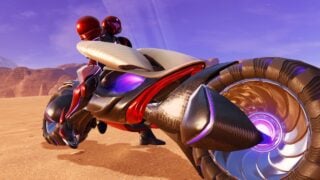Ratchet & Clank’s rifts could ‘easily’ have been done on PS3, claims Traveller’s Tales founder
Jon Burton says Insomniac’s claim that only the PS5 could pull it off is misleading

The founder of Traveller’s Tales has claimed that the rift effects in Ratchet & Clank: Rift Apart don’t need the PS5’s SSD to work, and could “easily” have been accomplished on hardware from two generations ago.
Jon Burton, who founded Traveller’s Tales (now TT Games) in 1989 and directed dozens of Lego crossover games before his 2019 departure, made the claims in a video on his new Coding Secrets channel.
Burton accuses Ratchet developer Insomniac of being somewhat “misleading” when it claimed the portal-travelling mechanic “would not have been possible without the Solid State Drive of PlayStation 5“.
The programmer goes on to claim that “the way the Rift gameplay was represented before launch was pretty misleading”, and that what was shown as “amazing sequences of Ratchet zipping between many other worlds all chained together into awesome action sequences” ended up being “mostly just cutscenes or very short sections of very limited gameplay”.
Burton makes it clear that he isn’t saying the PS5 is not using the SSD’s fast loading speeds to “do everything properly”, but that it’s not true to claim these set-pieces aren’t possible to pull off on older hardware.
In his video, Burton breaks down the two main Rift tricks in the game, and explains how he believes they could be pulled off on PS4 or even PS3 hardware.
He claims that the bonus Pocket Dimension areas are the easiest to pull off, because they’re small stages with limited scenery in them.
“Now, they could be using all kinds of Solid State Drive trickery to pull these off,” Burton says, “but because it’s just one Rift and it always goes to the same area this can easily be achieved on older hardware.”
Going into an explanation of asset streaming techniques for those unfamiliar with the process, Burton then points out: “The Pocket Dimensions are really graphically basic, and in fact just seem to use a lot of the same generic objects like crates that would already be available in generic memory.
“So it’s pretty much a sky dome, a few small platforms, generic objects and nice lighting, so on older hardware it wouldn’t take much memory, especially as it also uses the generic objects, all of which make it quick to load.”
Moving onto the more spectacular set-pieces where players jump quickly from Rift to Rift, Burton explains that these could also be pulled off with clever use of buffers.

Using an example section where Ratchet is on a speeder bike, goes through a portal and lands on a grind rail, Burton states that the game is deliberately placing the player into very small stages and giving them limited control to help manage the data it’s streaming in.
“The important thing to note here is that none of this is optional, it’s forced,” Burton explains. “This is important because it means you can pre-load the grind rail section while you are playing the speeder section. In fact, every section of this sequence is both forced and small.
PlayStation 5 at retail
“You only move across a very small part of the world and have very little ability to even move during this section – this means the game has the whole time you’re playing the section to load in the next section.
“So imagine the game has two memory buffers. The first buffer holds the section you’re currently playing in. While you’re playing, it can load the next section into the second buffer. To transition between the buffers you can just have a very simple intermediate Void location permanently in memory to hide any swap-over glitches that might happen.”
After explaining the method in more detail, Burton explains that it’s perfectly possible that the game could be using the SSD to “do everything properly”.
“I’m just explaining how other pretty simple techniques can be used to achieve exactly the same thing on older hardware,” he states.
He then demonstrates this by showing a section he designed for Lego Star Wars III on the PS3, where two separate gameplay stages are playing on-screen at the same time.
In a video posted on the PlayStation YouTube channel a year before the release of Ratchet & Clank: Rift Apart, Insomniac’s creative director Marcus Smith claimed the game’s rift-travelling mechanic was impossible on previous systems.
“Ratchet & Clank: Rift Apart is a game that utilizes dimensions and dimensional rifts, and that would not have been possible without the Solid State Drive of the PlayStation 5,” Smith stated.
“The SSD is screamingly fast. It allows us to build worlds and project players from one place to another in near instantaneous speeds. It is an unbelievable game changer in terms of we can now do gameplay where you’re in one world, and the next moment you’re in another.
“We’re loading up levels that happen so quickly and in the action that you don’t even imagine that this is something that we couldn’t do before because it feels so natural.”
This claim was later dialled back somewhat after the game launched, when game director Mike Daly told Axios: “You could make a game like [the new] ‘Ratchet & Clank’ on the PS4, but just visually speaking, you would have to dial back a ton in order to get it to run.”















